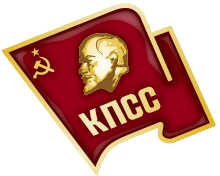RKP(b)
|
Communist Party
of the Soviet Union Коммунистическая партия Советского Союза |
|
|---|---|
 |
|
| Founder | Vladimir Lenin |
| Founded | January 1912 as RSDLP(b) March 1918 as RCP(b) December 1925 as VKP(b) October 1952 as CPSU |
| Banned | 29 August 1991 All-Soviet territory 6 November 1991 RSFSR territory |
| Preceded by | RSDLP |
| Succeeded by |
De jure: None Self-proclaimed: CPSU (1992) CPRF |
| Newspaper | Pravda |
| Youth wing |
Komsomol Young Pioneers |
| Membership | 19 million (1986) |
| Ideology |
Communism Marxism–Leninism |
| Political position | Far-left |
| International affiliation |
Second International (1912–1914) Comintern (1919–1943) Cominform (1947–1956) |
| Colours | Red |
| Slogan | «Пролетарии всех стран, соединяйтесь!» ("Workers of the world, unite!") |
| Anthem | "The Internationale" |
The Communist Party of the Soviet Union (Russian: Коммунисти́ческая па́ртия Сове́тского Сою́за, tr. Kommunistícheskaya pártiya Sovétskogo Soyúza, IPA: [kəmʊnʲɪsʲtʲˈitɕɪskəjə ˈpartʲɪjə sɐvʲˈetskəvə sɐˈjuzə]), abbreviated in English as CPSU (Russian: КПСС, tr. KPSS, which was the founding and ruling political party of the Union of Soviet Socialist Republics (USSR or Soviet Union). The CPSU was the sole governing party of the Soviet Union until 1990, when the Congress of People's Deputies modified the article of the constitution which had granted the CPSU a monopoly over the political system. The party was founded in 1912 by the Bolsheviks (a faction of the Russian Social Democratic Labour Party, RSDLP), a revolutionary group led by Vladimir Lenin which seized power in the aftermath of the October Revolution of 1917. The party was dissolved on 29 August 1991 on Soviet territory soon after a failed coup d'état and was completely abolished on 6 November 1991 on Russian territory.
The CPSU was a communist party organized on the basis of democratic centralism, a principle conceived by Lenin that entails democratic and open discussion of policy issues within the party followed by the requirement of total unity in upholding the agreed policies. The highest body within the CPSU was the party Congress, which convened every five years. When the Congress was not in session, the Central Committee was the highest body. Because the Central Committee met twice a year, most day-to-day duties and responsibilities were vested in the Politburo, the Secretariat and the Orgburo (until 1952). The party leader was the head of government and held the office of either General Secretary, Premier or head of state, or some of the three offices concurrently—but never all three at the same time. The party leader was the de facto chairman of the CPSU Politburo and chief executive of the Soviet Union. The tension between the party and the state (Council of Ministers of the Soviet Union) for the shifting focus of power was never formally resolved, but in reality the party dominated and a paramount leader always existed (first Lenin and thereafter the General Secretary).
...
Wikipedia
